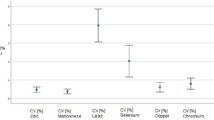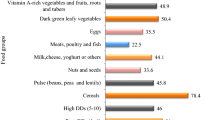Abstract
Aim: To evaluate selenium (Se) and copper (Cu) concentrations in Greek and Albanian immigrant mothers and in the cord blood of their newborns.
Subjects and methods: From 1118 Greek and 820 Albanian mothers and from the cord blood of their neonates blood was obtained for Se and Cu measurement. Se and Cu concentrations were determined in sera with graphite furnace atomic absorption spectroscopy (GFAAAS) and atomic absorption spectrometry, respectively. In all, 30 days' nutrient intakes were evaluated in both groups.
Results: Animal protein, Se and Cu intakes were poor in the Albanians vs the Greeks (P<0.001). Se concentrations in the Greek mothers (68.3±8.5 μg/l) and in their newborns (37.02±8.9 μg/l) were found higher as compared with those in Albanian mothers (37.4±9.9 μg/l) and in their newborns (34.3±9.1 μg/l) (P<0.001). Cu levels were also found higher (P<0.001) in the Greek mothers (1687±353 μg/l) and in their neonates (449±87 μg/l) compared with those in the Albanian mothers (959±318 μg/l) and in their newborns (229±67 μg/l). Additionally, 31.5% of neonates born to Albanian women with Se concentrations less than 28 μg/l had higher Se levels (P<0.01) than their mothers.
Conclusions: The low Se and Cu levels evaluated in the Albanian mothers and their newborns could be related to their poor animal protein intake which could be the consequence of their low socioeconomic status. As an effective preventive measure, accurate dietetic strategies to assess the requirements of pregnant immigrant women for trace elements may be planned in Greece.
This is a preview of subscription content, access via your institution
Access options
Subscribe to this journal
Receive 12 print issues and online access
$259.00 per year
only $21.58 per issue
Buy this article
- Purchase on Springer Link
- Instant access to full article PDF
Prices may be subject to local taxes which are calculated during checkout

Similar content being viewed by others
References
Agget PJ (1994): Aspects of neonatal metabolism of trace metals. Acta Paediatr. 402 (Suppl), 75–82.
Bhaskaran P (1995): Micronutrient deficiencies in children the problem and extend. Indian J Pediatr. 62, 145–156.
Black RE (1989): Micronutrients in Pregnancy. Br. J. Nutr. 2 (Suppl), S193–S197.
Bratakos MS & Ioannou PV (1989): The regional distribution of selenium in Greek cereals. Sci. Total Environ. 84, 237–247.
Bratakos MS, Kanaki HC, Vasiliou-Waite A & Ioannou PV (1990): The nutritional selenium status of healthy Greeks. Sci. Total Environ. 91, 161–176.
Butler JA, Whanger PD & Tripp MJ (1982): Blood selenium and glutathione peroxidase activity in pregnant women comparative assay in primates and other animals. Am. J. Clin. Nutr. 36, 15–23.
Chan S, Cerson B & Subramaniam S (1998): The role of copper, molybdenum, selenium and zinc in nutrition and health. Toxicology 18, 673–685.
Cohen-Kerem R & Koren G (2003): Antioxidants and fetal protection against ethanol teratogenicity. Review of the experimental data and implications to humans. Neurotoxic. Teratol. 25, 1–9.
Dorea JG, Brito M & Araujo MOG (1987): Concentration of copper and zinc in liver of fetuses and infants. J. Am. Coll. Nutr. 6, 491–495.
Gathwala G, Vadav OP, Singh I & Sangwan K (2000): Maternal and cord plasma selenium levels in full term neonates. Indian J. Pediatr. 67, 729–731.
Gathwala C & Vadav OP (2002): Selenium in the neonate. Indian J. Pediatr. 69, 443–446.
Horning MS, Blakemore LJ & Trombley PQ (2000): Endogenous mechanisms of neuroprotection: role of zinc, copper and carnosine. Brain Res. 852, 56–61.
Keshan Disease Research Group (1979): Selenium in heart of China. Lancet 2, 889–890.
King JC (2000): Physiology of pregnancy and nutrient metabolism. Am J Clin Nutr 71 (Suppl), 1218–1225.
Paul AA, Southgate DA & Russel J (1980): The Composition of the Food. London: HMSO.
Rossipal E, Krachler M, Li F & Micetic-Turk D (2000): Investigation of the transport of trace elements across barriers in humans: studies of placental and mammary transfer. Acta Paediatr. 89, 1190–1195.
Schawartz K & Foltz C (1957): Selenium as an integral part of factor-3 against dietary necrotic liver degeneration. J. Am. Chem. Soc. 79, 3292–3293.
Sheehan TM & Halls DJ (1999): Measurement of selenium in clinical specimens. Ann. Clin. Biochem. 36, 301–315.
Thomas B (2001): Manual of dietetic practice. Nutritional Sciences. Nutr. Healthcare, pp 217–225. McGraw-Hill 1998, NY.
Terres-Martos C, Navarro-Alarcon M, Martin-Lagos F, Lopez-Carcia de la Serrana H & Lopez Martinez MC (1997): Determination of Cu levels in serum of healthy subjects by atomic absorption spectometry. Sci. Total Environ. 198, 97–103.
Turner RE, Langkamp-Henken B, Little RC, Lukowski MJ & Suarez MF (2003): Comparing nutrient intake from food to the estimated average requirements shows middle to upper income pregnant women lack iron and probably magnesium. J. Am. Diet. Assoc. 103, 461–466.
Varo P, Alfthan G, Huttunen JK & Antti A (1994): Nation wide selenium supplementation in Finland. Effect on diet, blood and tissue levels and health. In: Selenium in Biology and Human Health, ed. RF Burke, pp 207–208. New York: Springer Verlag.
Volpe JJ (1995): Hypoxic–ischaemic encephalopathy: biochemical and physiological aspects. In: Neurology of the Newborn, ed. JJ Volpe, pp 211–259. 3rd ed. Philadelphia: W.B. Saunders Company.
Vuori E, Makinen SM, Kara R & Kuitunen P (1980): The effect of dietary intakes of copper, iron, manganese and zinc. Am. J. Clin. Nutr. 13, 227–231.
Widdowson EM (1981): The demands of the fetal and maternal tissues for nutrients and the bearing of these on the needs of the mother to “eat for two”. In: Maternal Nutrition in Pregnancy-Eating For Two, ed. J. Dobbing, pp 1–19. London: Academic Press.
Acknowledgements
We are grateful to Mrs Anna Stamatis for her careful typing of this manuscript.
Author information
Authors and Affiliations
Contributions
Contributors: KHS was involved in the design of the study and in writing the manuscript. Measurements of biochemical parameters were performed by TK and GC. SG, GK and GV collected the samples and records. Data analysis, editing of the manuscript and study coordination were performed by IP.
Corresponding author
Rights and permissions
About this article
Cite this article
Schulpis, K., Karakonstantakis, T., Gavrili, S. et al. Maternal – neonatal serum selenium and copper levels in Greeks and Albanians. Eur J Clin Nutr 58, 1314–1318 (2004). https://doi.org/10.1038/sj.ejcn.1601967
Received:
Revised:
Accepted:
Published:
Issue Date:
DOI: https://doi.org/10.1038/sj.ejcn.1601967
Keywords
This article is cited by
-
Associations of Internal-Migration Status with Maternal Exposure to Stress, Lead, and Selenium Deficiency Among Pregnant Women in Shanghai, China
Biological Trace Element Research (2019)
-
Evaluation of Mineral Concentrations in Maternal Serum Before and After Birth and in Newborn Cord Blood Postpartum—Preliminary Study
Biological Trace Element Research (2018)
-
Umbilical Serum Copper Status and Neonatal Birth Outcomes: a Prospective Cohort Study
Biological Trace Element Research (2018)
-
Study of the Concentration of Trace Elements Fe, Zn, Cu, Se and Their Correlation in Maternal Serum, Cord Serum and Colostrums
Indian Journal of Clinical Biochemistry (2014)
-
Changes in the concentrations of biochemical indicators of diet and nutritional status of pregnant women across pregnancy trimesters in Trujillo, Peru, 2004–2005
Nutrition Journal (2013)



